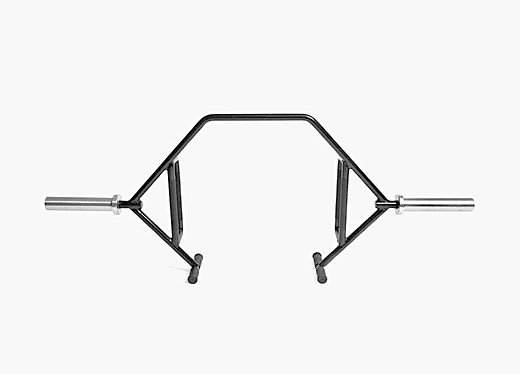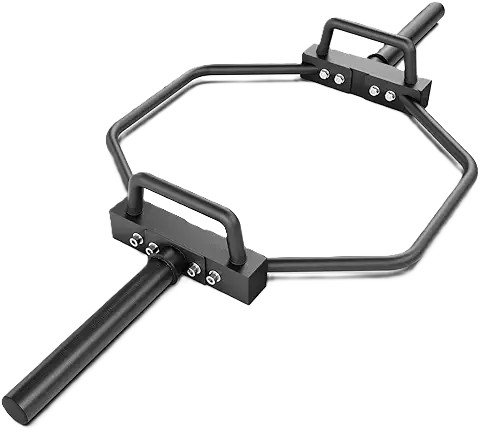Training for Athletic Performance & Injury Prevention
When I began researching this topic, I was coming at it from two different but very connected perspectives. First, as a man in my 40s, I’m always on the lookout for ways to stay pain-free, or at the very least, minimize the daily aches and stiffness that come with aging. While I’m not trying to be an athlete in the traditional sense anymore, I’ve discovered that training like an athlete does wonders for how my body feels. Over time, I’ve learned that what improves athletic performance often improves overall movement quality, posture, and body awareness, things that are essential for staying active and avoiding chronic pain.
Building strength has been a game-changer. When you have good muscular support, your posture improves, your joints are more stable, and everything just feels better aligned. That means fewer mornings waking up with a stiff back or nagging shoulder pain. So naturally, I started asking myself: how can I train for athletic performance in a way that supports longevity and reduces my risk of injury?
In the past, I experimented with explosive training like box jumps and used resistance bands to mimic high-speed athletic movements. While those workouts definitely felt “athletic,” they often came with a cost, minor injuries that added up and disrupted my consistency. I needed something that allowed me to move powerfully and purposefully without constantly flirting with the injury line. That’s when I started digging deeper into how to train athletic performance more safely and sustainably.
The second perspective I brought to this research is as a father. My 13-year-old son is just beginning his weight training journey as part of his development as an athlete. He’s tall, lean, and has a mild case of scoliosis. As excited as I am for him to begin building strength, I’ve been cautious about introducing him to exercises like barbell squats and deadlifts, which can put a lot of load directly on the spine. My biggest question became: what could help improve athletic performance in young athletes, especially those with special considerations like spinal alignment issues?
This dual thinking, for my own performance and injury prevention, and for my son’s safe development, led me to explore smarter, safer ways to build strength. That journey brought me to the hex bar, or trap bar. Its design offers a more joint-friendly setup for both deadlifts and squats, keeping the load centered and reducing the strain on the lower back. For me, it felt like a way to stay strong and loose in the hips without the usual wear and tear. For my son, it felt like a safer entry point into strength training that could still teach him how to move well and build confidence.
So in trying to figure out how to train athletic performance without risking injury, the hex bar became an interesting solution, one that could check both boxes: Could it help us move better and get stronger, while lowering the risk of injury?
So, what did I find out?
Benefits of Using a Hex Bar
Enhanced Lifting Mechanics
One of the key advantages of the hex bar is its design, which places the lifter inside the frame rather than behind the bar. This positioning aligns the weight with the body’s center of gravity, encouraging a more upright torso and reducing the forward lean typically seen in conventional deadlifts. This subtle but significant shift in body mechanics can help protect the spine by minimizing the shear forces placed on the lumbar region.
Maintaining a more vertical spine not only improves lifting efficiency but also reduces the risk of injury, especially to the lower back, which is one of the most common areas of strain in traditional deadlifts. The hex bar allows lifters to stay more stacked and aligned, making it easier to brace the core and engage the right muscles throughout the lift. This is particularly beneficial for people with existing back issues or those looking to avoid them altogether.
Another major plus is the hex bar’s neutral grip handles. Unlike the pronated or mixed grips often used with straight bars, the neutral grip promotes a more natural wrist and shoulder alignment. This reduces strain on the joints and makes lifts more comfortable, especially for individuals dealing with shoulder impingement or limited mobility. It’s a user-friendly solution that makes heavy lifting more accessible to a wider range of athletes and fitness levels.
Increased Power and Strength
The hex bar isn’t just about safety, it also delivers when it comes to performance. Numerous studies, including a notable one published in the Journal of Strength and Conditioning Research, have shown that lifters produce greater peak force, velocity, and power output with the hex bar compared to a straight barbell (Swinton et al., 2011). This suggests that the hex bar is highly effective for building the type of explosive strength critical in athletic performance.
One reason for this increased output is the more efficient body position. Since the lifter is standing within the bar, the lift starts from a mechanically stronger position, allowing more force to be transferred through the floor. This enhanced leverage translates into the ability to lift heavier loads or lift moderate loads faster, both key components of power development. It also helps athletes build confidence by enabling heavier lifts with safer mechanics. Can you imagine trying to do any kind of explosive jumping exercise using a barbell.
Additionally, the hex bar allows for a smoother learning curve. For new lifters or youth athletes, the movement pattern feels more natural than the traditional deadlift. This faster learning process, combined with the ability to generate high force production, makes the hex bar a valuable tool in both youth and beginners but also advanced strength programs. It supports gains in power and strength without the technical barrier that often comes with straight bar lifts.
Balanced Muscle Activation
One of the standout features of the hex bar is its ability to recruit both the anterior and posterior chain muscles in a balanced way. Traditional deadlifts often heavily emphasize the posterior chain, glutes, hamstrings, and lower back, while the hex bar deadlift, due to its upright torso position, also brings the quads more into play. This makes the movement more comprehensive and functional for full-body development.
Balanced activation is particularly important for injury prevention and movement quality. Many athletes or recreational lifters develop imbalances due to overemphasis on one muscle group or training pattern. By engaging both sides of the body evenly, the hex bar helps create a more stable and resilient musculoskeletal system. This is especially beneficial for people recovering from injury or those looking to avoid chronic overuse problems down the line.
Additionally, the hex bar allows athletes to train in multiple planes and ranges of motion. Because of the reduced technical demand, lifters can better focus on muscle engagement and controlled movement. The result is a more mindful approach to lifting, with increased muscle recruitment across the hips, legs, and trunk. This balanced workload not only builds strength but improves coordination and movement fluidity, which are essential components of athletic performance.
Versatility in Training
While most people associate the hex bar primarily with deadlifts, its design actually lends itself to a wide variety of exercises. From hex bar squats and lunges to farmer’s carries and shrugs, the tool is incredibly versatile. This variety allows lifters to target multiple movement patterns and muscle groups without needing to switch equipment constantly. It’s particularly effective in functional training environments where space or equipment may be limited.
For athletes, this versatility is gold. You can train for strength, weight gain, endurance, or power using a single implement. Farmer’s carries with a hex bar, for example, offer a fantastic core and grip challenge, while hex bar jumps can help develop explosive lower body power without the joint strain that comes from traditional plyometrics. It’s this adaptability that makes the hex bar a staple in many athletic training programs.
Additionally, for youth athletes or beginners who are still developing motor control, the hex bar offers a safer entry point into resistance training. Movements like hex bar squats are easier to learn and load progressively, reducing the likelihood of technical breakdown. It’s a flexible, coach-friendly tool that can scale with the athlete’s development and training goals over time.
Reduced Injury Risk
Perhaps one of the most compelling benefits of using the hex bar is its contribution to injury prevention. The improved lifting mechanics, upright torso, neutral grip, and centered load help reduce stress on vulnerable areas like the lower back, knees, and shoulders. For individuals getting up there in age, a history of injuries, or those just starting out, this can make a significant difference in long-term consistency and safety in training.
In particular, the neutral grip reduces the internal shoulder rotation that can occur with straight bar lifts. This can be a game-changer for people dealing with shoulder impingement or instability. The ergonomic hand positioning helps lifters maintain better alignment throughout the movement, allowing them to focus on building strength without the nagging discomfort that sometimes comes from poor positioning.
Lastly, because lifters tend to have better control and posture with the hex bar, there’s a lower likelihood of compensation that can lead to overuse injuries. For coaches, therapists, and recreational lifters alike, the hex bar provides a safer training environment while still offering all the benefits of traditional strength training. It’s a tool that promotes performance, but not at the cost of health.
Best Exercises with a Hex Bar
Hex Bar / Trap Bar Deadlift
The hex bar deadlift is a staple movement in strength training, especially beneficial for those looking to build lower-body and posterior chain strength with reduced injury risk. Unlike a traditional barbell deadlift, the hex bar positions the weight at the sides of the body, which helps center the load and promote a more upright torso. This position reduces stress on the lumbar spine, making it a safer alternative for individuals with lower back concerns. The neutral grip also places less strain on the wrists and shoulders, allowing for a more natural pulling motion. As a result, the hex bar deadlift is an excellent choice for athletes of all levels looking to build strength, power, and confidence in their lifting technique.
Hex Bar / Trap Bar Squat
The hex bar squat is an underutilized variation that offers a hybrid between a squat and a deadlift. By gripping the handles of the hex bar and lowering into a squat, lifters maintain a more upright torso compared to traditional back or front squats, which shifts more emphasis to the quads and glutes while still engaging the core and hamstrings. This posture-friendly positioning is ideal for individuals with mobility restrictions or those recovering from back or shoulder injuries. Additionally, the neutral grip eliminates the need to support a bar on the upper back or shoulders, making the movement more comfortable and accessible. It’s a great alternative for anyone looking to build lower-body strength with better joint alignment and control.
Differences Between Hex Bar / Trap Bar Squat & Deadlift
The hex bar squat and hex bar deadlift may use the same equipment, but they differ significantly in movement mechanics and muscle focus. The hex bar deadlift is a hip hinge movement that emphasizes the posterior chain, glutes, hamstrings, and lower back, while the hex bar squat is more knee-dominant, targeting the quads and glutes with a more upright torso position. Deadlifts start from the floor and involve lifting from a dead stop, whereas squats typically begin from a standing position and focus on controlled descent and ascent. Posture also differs, with deadlifts requiring a slight forward lean and squats sits with the butt down further which encourages a straighter spine. In short, hex bar deadlifts are ideal for developing raw strength and posterior power, while hex bar squats are better for quad development and joint-friendly leg training.
Hex Bar / Trap Bar Farmer's Carry
The hex bar is a perfect tool for loaded carries, also known as farmer’s carries. Simply gripping the handles and walking for a set distance or time challenges multiple muscle groups at once, particularly the forearms, traps, core, and legs. This exercise is excellent for improving grip strength, postural stability, and cardiovascular endurance. Because the load is balanced and centered with the hex bar, it offers a more comfortable and manageable experience compared to traditional dumbbells or kettlebells. In addition to athletic benefits, farmer’s carries with a hex bar mimic real-world tasks—such as carrying groceries or heavy equipment—making them both functional and practical for everyday strength and conditioning.
Hex Bar/Trap Bar Jump Squat
The hex bar jump squat is an explosive power exercise that combines strength and speed, making it ideal for athletes looking to improve vertical jump, sprinting ability, and overall lower-body explosiveness. To perform it, load the hex bar with a light to moderate weight (30% of Body Weight), stand inside the frame, grip the handles, and lower into a partial squat. From there, explode upward into a jump while holding the hex bar, keeping the arms extended and the core engaged to stabilize the load. Land softly with bent knees to absorb the impact and reset before the next rep. Because the weight is centered and the grip is neutral, the hex bar allows for a safer and more balanced jump compared to barbell-loaded jumps, reducing strain on the spine and shoulders while still delivering powerful training results.
Hex Bar/Trap Bar Romainian Deadlifts
Romanian deadlifts (RDLs) with a hex bar offer a safe and effective way to target the hamstrings, glutes, and lower back. The movement emphasizes a hip hinge pattern that helps improve flexibility and strength in the posterior chain, which is essential for athletic performance and injury prevention. Using a hex bar for RDLs provides a balanced and stable grip, encouraging better control throughout the eccentric (lowering) phase. This is especially beneficial for beginners who may struggle with barbell placement or form. Additionally, the reduced forward load and neutral grip can help lifters focus more on engaging the hamstrings and glutes rather than overloading the lower back, making it an ideal accessory lift for building posterior strength and movement efficiency.
What muscles are worked
The Hex Bar/Trap Bar vs. Traditional Barbell
Muscle Activation
- Deadlift with Traditional Barbell had 14% more Hamstring activation
- Deadlift with Traditional Barbell had 21% more erector spinae (Low back muscle activation.).
- Hex Bar / Trap Bar had 21% more quad activation
- Hex Bar / Trap Bar had 13% more power production than a standard dead lift.
- Hex Bar / Trap Bar also had 2% more force production
Comparing Hex/Trap Bar to Traditional Barbells
While both hex bars and traditional barbells are effective for strength training, they offer different advantages:
Biomechanics: The hex bar promotes a more upright torso, reducing lumbar spine stress, whereas the straight barbell requires more forward lean, increasing posterior chain (Hamstrings and Glutes) engagement.
Muscle Activation: Hex bar lifts emphasize quadriceps more due to increased knee flexion, while traditional deadlifts target the hamstrings and lower back more intensely.
Learning Curve: Beginners may find the hex bar easier to learn due to its ergonomic design and natural movement patterns.
Versatility: Both bars offer versatility, but the hex bar’s design allows for a broader range of exercises with reduced injury risk.
Top 5 Hex Bar / Trap Bar's
🥇 1. REP Fitness Open Trap Bar
This bar stands out with its versatility and thoughtful design.
Pros:
Versatile Design: The open-ended frame and removable handles allow for a wide range of exercises, including deadlifts, lunges, and presses.
Built-in Deadlift Jack: This feature makes loading and unloading plates effortless, saving time and energy during workouts.
High Weight Capacity: With a 1,350 lb capacity, it caters to both novice and advanced lifters.
Cons:
Handle Width: The 27″ handle spacing might be too wide for users with a narrower frame.
Stability Concerns: Some users have noted that the bar isn’t as stable as other models during certain lifts.
Price Point: At around $400, it might be a significant investment for some home gym owners.
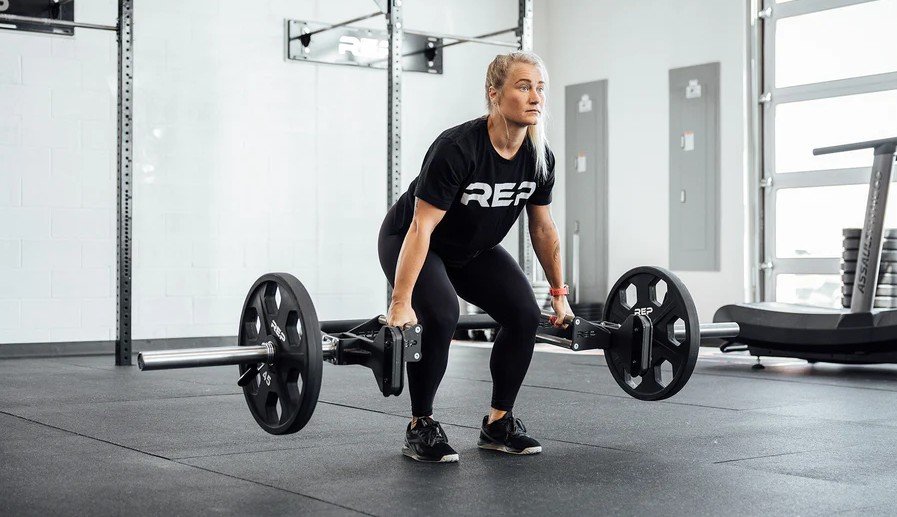
Price: $349.00
🥈 2. Rogue TB-1 Trap Bar 2.0
A robust and reliable choice for those seeking durability and performance.
Pros:
Durable Construction: Made with thick steel and robotic welds, it’s built to last.
Aggressive Knurling: Provides a secure grip, especially beneficial for heavy lifts.
Rackable Design: Allows for a variety of exercises beyond deadlifts.
Cons:
Knurling Intensity: The aggressive knurling might be too harsh for some users, potentially causing discomfort.
Finish Durability: The powder-coated sleeves are prone to chipping over time.
Lack of Knurl Marks: Absence of knurl marks can make hand placement less intuitive.
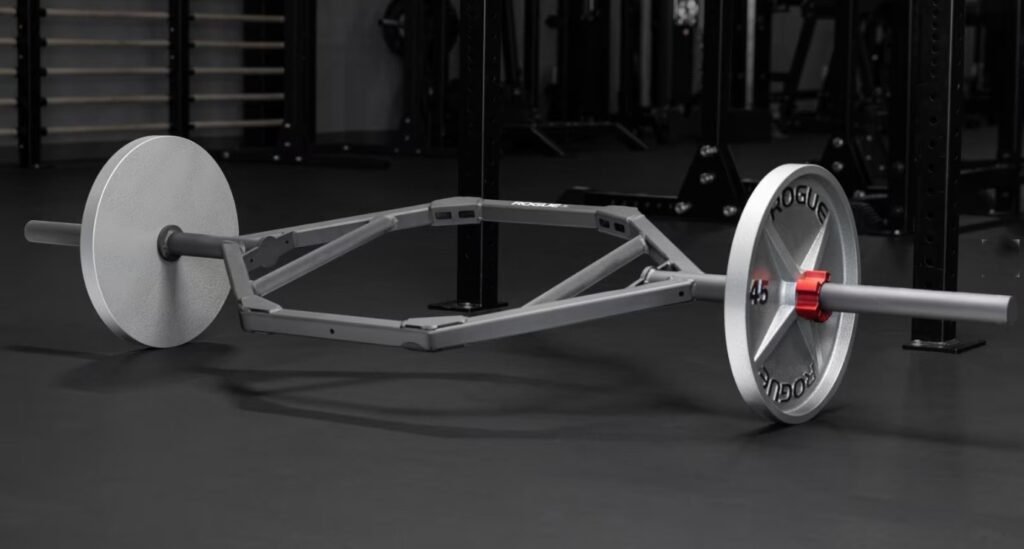
Price: $335.00
🥉 3. Bells of Steel Open Trap Bar
An excellent budget-friendly option with notable features.
Pros:
Affordable Price: Offers great value with features like a built-in deadlift jack and rotating sleeves.
Open-End Design: Enhances versatility, allowing for a broader range of movements.
Rotating Sleeves: Facilitates smoother lifts and reduces strain on the wrists.
Cons:
Limited Sleeve Length: Short sleeves restrict the amount of weight that can be loaded, especially with bumper plates.
Weight Capacity: With a 700 lb limit, it might not suffice for advanced lifters.
Knurling Quality: Some users find the knurling to be less aggressive, affecting grip during heavy lifts.
🏅 4. Giant Northland Open Trap Hex Bar
A solid choice for those prioritizing budget and basic functionality.
Pros:
Cost-Effective: Provides essential features like dual handles and a built-in jack at a reasonable price.
Rackable: Enhances exercise variety and storage convenience.
Positive Reviews: Users appreciate its value and performance for the price point.
Cons:
Balance Issues: Some users report that the bar isn’t perfectly balanced, which can affect certain lifts.
Fixed Handles: The non-adjustable handles might not suit all body types or exercise preferences.
Weight Limit: The 800 lb capacity may not meet the needs of more advanced lifters.
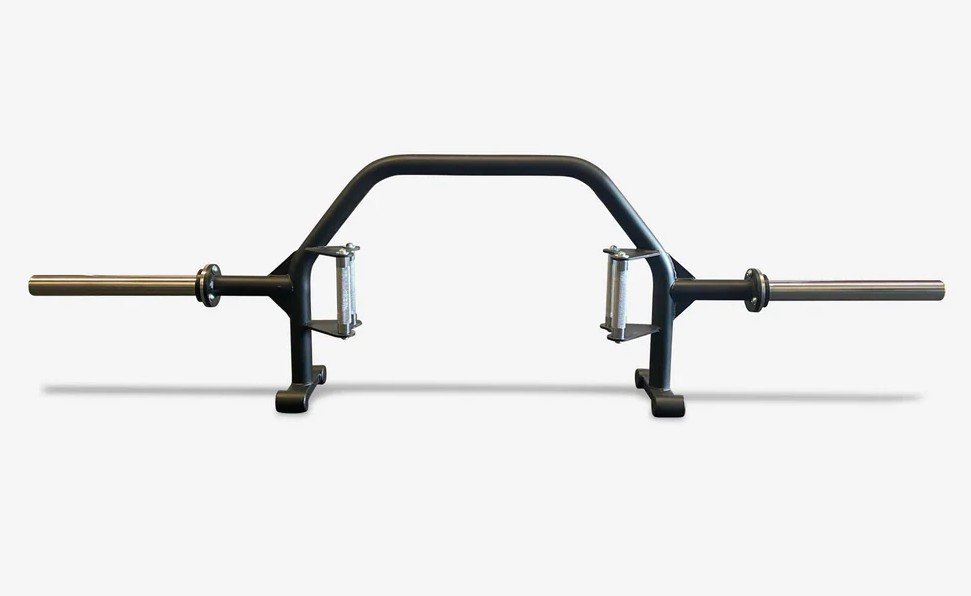
Price: $349.00
🎖️ 5. Synergee Hex Trap Bar
A basic, no-frills option suitable for beginners or those on a tight budget.
Pros:
Budget-Friendly: One of the most affordable trap bars available.
Dual Handles: Offers versatility in grip positions for different exercises.
Compact Design: Its smaller size makes it suitable for home gyms with limited space
Cons:
Short Sleeves: The 10″ sleeves limit the amount of weight that can be loaded.
Non-Rackable: Cannot be used with standard racks, reducing exercise variety.
Lower Weight Capacity: With a 500-750 lb limit, it may not accommodate heavier lifters.
Each of these trap bars has its strengths and fits different needs and budgets. The REP Fitness Open Trap Bar stands out for its versatility and features, making it a top choice for serious lifters. On the other hand, if you’re just starting out or working with a tight budget, the Synergee Hex Trap Bar is a solid, functional entry point into trap bar training.
I personally own both #1 (REP) and #5 (Synergee). I started with the Synergee 7KG because of the low cost and the fact that I wasn’t quite sure yet what I really wanted or needed. Plus, I’m not a heavy lifter—and neither is my 13-year-old. We recently upgraded to the REP bar because of its added versatility and the ability to perform more types of exercises.
My recommendation: start with the Synergee 7KG or 25KG if you’re not an experienced lifter, if you’re unsure about sizing, or if you have a smaller build and don’t plan to load up heavy weight. But if you’re a more experienced lifter, enjoy stacking the plates, or want a bar that gives you more exercise variety, the REP bar is a fantastic option.
Hex Bar/Trap Bar Final Thoughts and Opinions
My biggest takeaway when it comes to athletic performance in both youth and older adults is that there are so many tools out there to support your health and wellness journey. The key is using the right tool for the right job. Different equipment can give you different results, and it’s smart to switch things up to target various parts of the body more effectively.
So where does the hex bar really shine? Injury prevention is the big one. Being able to keep a neutral body position while lifting helps protect your back, shoulders, and neck, which are areas that can easily get tweaked when using traditional barbells. For older adults like me, and for growing youth athletes, that’s a huge win.
The second big benefit? Explosive power and movement development. Whether you’re younger or older, if you’re looking to get stronger and more powerful, the hex bar is a great tool. It lets you load up more weight while keeping your body in a safe, neutral position (feet flat, spine aligned), which gives you a better, more efficient workout. It also works really well for dynamic movements like full jumps or ankle hops using lighter weight, great for building speed and power.
My son and I have been using the hex bar for about 90 days now, and we’ve both seen solid strength gains, and most importantly, no nagging injuries. I usually stick with the basics like hex bar squats or deadlifts, while my son (who’s a track athlete) focuses on fast, explosive lifts with lighter weights. It’s been a huge help in his jumping events, he’s placed either first or second in every meet this season! And here’s the best part: this is the first full season he hasn’t had to sit out due to a minor leg injury, which used to be a regular thing for him.
So yeah, if you’re thinking about leveling up your workouts or helping a young athlete stay strong and injury-free, I’d definitely recommend having a hex bar in the garage. Add a few weights and you’re set. It’s been a total game changer for us.

